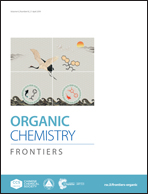Spirocyclic cladosporicin A and cladosporiumins I and J from a Hydractinia-associated Cladosporium sphaerospermum SW67†
Abstract
Here, we report the isolation and characterization of three new spirocyclic natural products named cladosporicin A (1), cladosporiumins I (2) and J (3) from the fungus Cladosporium sphaerospermum SW67. Cladosporicin A contains an unprecedented 2,7-diazaspiro[4.5]decane-1,4-dione skeleton conjugated with one 2,4-pyrrolidinedione moiety (tetramic acid). Cladosporiumins I and J are stereoisomers and are built of a tetramic acid core structure with a quaternary (C-3) center carrying a trans-hexylenic alcohol side chain and a six-membered lactone ring. The absolute structures of compounds 1–3 were elucidated by a combination of 1D and 2D NMR spectroscopy, modified Mosher's analysis, quantum chemical ECD calculations and computational NMR chemical shift calculations. Comparative genome sequence analysis led us to assign the putative new PKS-NRPS hybrid gene cluster (cls). Finally, we assessed bioactivities of compounds 1–3 in a series of pharmacological tests and found weak cytotoxicity against four human breast cancer cell lines (IC50 ∼ 70–90 μM).



 Please wait while we load your content...
Please wait while we load your content...